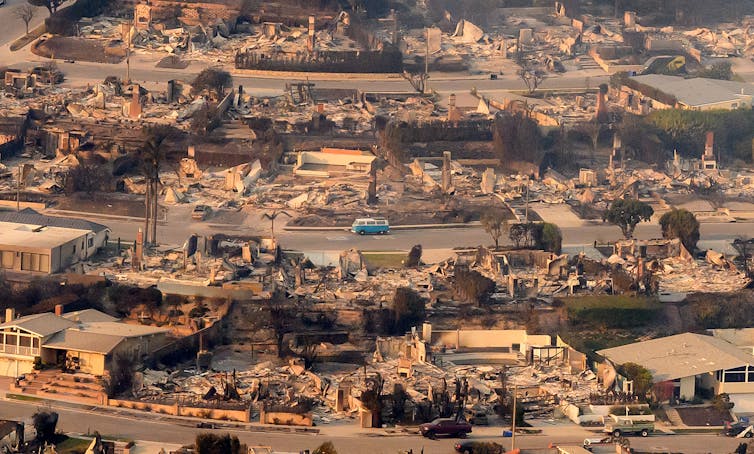Wildfires ravaging Los Angeles are setting the stage for a real estate nightmare.
Thousands of homes and other buildings were destroyed and hundreds of thousands of residents were evacuated multiple times. Many don't even come back for months. Instantly homeless, they are now flooding into the housing market, desperately seeking shelter.
The Los Angeles real estate market was ill-prepared for this crisis. It's already one of the most expensive markets in the country to buy or rent a home, largely due to a severe and growing shortage of affordable housing. With so many fire-stricken buildings destroyed, this shortage is only going to get worse.
For the past two years, I have been studying the impact of natural disasters like this on the rental housing market. As a real estate professor, I analyzed this problem from afar, sifting through the data.
This time, however, as a Pasadena resident, I witnessed the carnage up close. I watched from my back porch as the Eaton Fire spread into the mountains. I helped friends evacuate their neighborhoods before they were engulfed in flames. Now, they sit at my dining room table, processing their losses and finding new places to live.
Unfortunately, based on my research, I have no doubt about what happened next.
Why disasters drive up rents
Scarcity is the enemy of affordability. This is one of the core principles of economics. When too many people chase too few goods, prices rise.
So you might think that a natural disaster would destroy housing and flood the remaining units with new tenants, driving up rents, at least in the short term.
That’s exactly what my research found—but it’s not just about the short term.
Two years ago, I worked with a team of researchers to prepare a report for the Brookings Institution in which we compiled a database of natural disasters in major markets across the country from 2000 to 2020. We measured changes in rents across places like Atlanta, Detroit, Miami, and San Francisco, where landlords were asking for apartments in disaster-hit neighborhoods. We then compared these cities to similar communities that were not affected by the disaster.
We found that natural disasters increased rents by 4% to 6% over these two decades. This means rents are at least 4% higher than they would have been had the disaster not occurred.
In the wake of California’s wildfires, rent increases have been particularly pronounced and harmful.
These are not just short-term effects. It took 18 months for the market to feel the full effects, and they never fully went away. Even four years after the disaster, renters are still paying 2% to 3% more than they were when the disaster struck.
In short, we find that disasters permanently change the rental housing market. They eliminate older affordable housing, allowing developers to build newer, higher-end and even luxury housing in its place. These changes drive up insurance costs, and disasters prompt cities to adopt stricter building codes, which in turn increases building costs to better withstand future disasters.
How much rents rise, however, depends on how communities and authorities respond to disasters.

Federal aid could slow rent growth
We found that when the government stepped in to help, rents didn't grow as fast.
Specifically, we examine the market for congressional use of the Community Development Block Grant Disaster Recovery (CDBG-DR) program, which provides grants through the Department of Housing and Urban Development. This federal funding often comes with strings attached, and "rent requirements" often require a significant portion of the funding to be used to build affordable housing.
From 2003 to 2020, at least one disaster relief grant was awarded each year. In some years, Congress allocated as many as 27 different grants to different disaster-affected areas across the country.
In these markets, we found that rents continued to rise after the disaster, but at a significantly slower pace than in markets where Congress did not release disaster relief funds.
We dive into several cases in 2024 to understand why the CDBG-DR program is associated with lower rent increases in the long term. In this new study, we find that housing markets that benefited from these disaster relief grants were able to build more rental units, thereby alleviating the housing shortage. They improve affordability by directly addressing scarcity.
Rental units hold the key to solving the rental crisis. These cities had better affordability after the disaster but did not build more single-family homes than other cities. They built more apartment units.
In these markets, these disaster relief grants have saved the average renter $780 to $1,080 per year in housing costs through 2023.
We believe this finding illustrates why it is important not only to rebuild homes destroyed in disasters such as the Los Angeles fires, but also to create new rental opportunities for a variety of housing types.
hope afterwards
In Los Angeles, the clock is already ticking.
There are a growing number of news reports about landlords raising rents to eye-popping levels.
Fortunately, government policies and programs can help Angelenos find housing today and help keep the Los Angeles housing market from becoming even less affordable tomorrow.